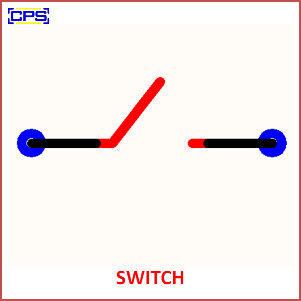A Switch is an electrical device used to control the flow of current in a circuit by opening (interrupting) or closing (completing) the electrical path. It allows users to manually or automatically turn circuits, devices, or systems on or off.

Key Features of a Switch:
- Two States:
- Open State: The circuit is incomplete, and no current flows.
- Closed State: The circuit is complete, allowing current to flow.
- Types of Operation:
- Can be mechanical (manually operated) or electronic (controlled by signals).
- Contact Mechanism:
- Uses conductive materials like metal for reliable current flow when closed.
Types of Switches:
- Based on Poles and Throws:
- Single Pole Single Throw (SPST): Simple on/off functionality.
- Single Pole Double Throw (SPDT): Directs current to one of two paths.
- Double Pole Single Throw (DPST): Controls two circuits simultaneously.
- Double Pole Double Throw (DPDT): Controls two circuits with two outputs each.
- Specialized Types:
- Toggle Switches: Operated by a lever or handle.
- Pushbutton Switches: Operated by pressing a button.
- Slide Switches: Operated by sliding a knob or bar.
- Rotary Switches: Operated by rotating a dial.
- Electronic Switches: Controlled by electronic signals (e.g., transistors, MOSFETs).
Applications of Switches:
- Home Appliances:
- Turning lights, fans, and other devices on or off.
- Industrial Systems:
- Controlling heavy machinery and electrical circuits.
- Electronics:
- Used in devices like computers, smartphones, and audio equipment.
- Automotive:
- Ignition, lighting, and other controls in vehicles.
Advantages:
- Simple and reliable method for controlling circuits.
- Wide range of designs for various applications.
- Durable and long-lasting when properly maintained.
Disadvantages:
- Mechanical switches may wear out over time due to physical operation.
- Requires manual intervention unless automated.
